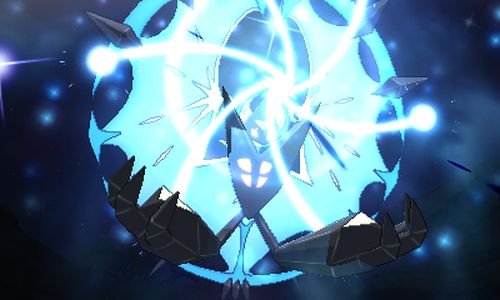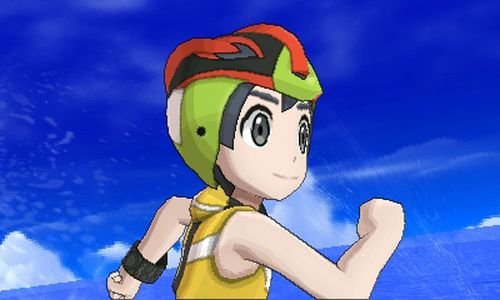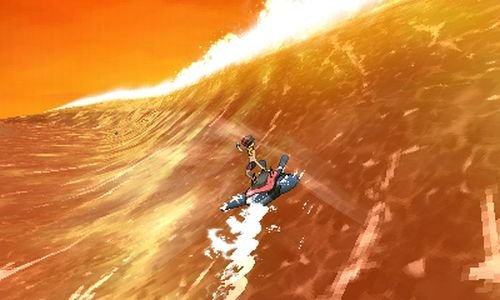It’s always tricky, coming to review one of these “updated” Pokémon games. Not least because my word processor refuses to recognise the word “Pokémon” and seems to think it’s some mysterious ancient glyph. But also because it’s difficult to know where to dole out praise and where to give criticism. Do I simply talk about the new features and whether they justify “double-dipping?” Do I consider the game in a vacuum? Do I babble at length about how cute and strong my Vaporeon is? I suppose the professional thing to do would be to do all three.

Pokémon Ultra Sun and Ultra Moon are the product of Game Freak realising they missed out on making a “Pokémon Z” update to Pokémon X and Y, so are now double-dipping on their double-dip games (Quadruple-dipping?). These re-releases generally consist of adding new Pokémon to the region (like my amazing and powerful Vaporeon), tweaking the story a little, and scattering a few new features here and there to keep things feeling fresh. USUM do not stray from this mission statement in the slightest.

Let’s focus on the new to begin with. The story now focuses around the prism Pokémon Necrozma (official classification the “weird black husk thing” Pokémon) and its ambition, if Pokémon can have ambitions, to steal all the light from the Alola region. It does this by having a couple of cosplayers’ worst nightmares meeting you at random intervals and telling you it wants to do this and how scary it is, despite not seeing it until nine tenths through the game. All of the existing supporting characters are also understandably rather concerned, and critics have previously suggested this leaves the story feeling one-dimensional and bland – but each character also undergoes new arcs that makes them feel more human than their Sun and Moon appearances. Hau strives a lot more for self-improvement rather than being “Sunny Disposition Character 14b;” Lusamine and Guzma change from a one-dimensional lunatic and a bully to more sympathetic characters; Lillie is still terrible, but in new and exciting ways.

Other little tweaks are made here and there; the introduction sequence up to getting your first Pokémon has been mercifully shortened, for starters (make sure to read in the voice of somebody forcing a terrible pun, you know the one). A couple of the Trail Captains have had their challenges tweaked, and lots now culminate in a battle with a different Totem Pokémon – many of which are significantly more difficult than their predecessors, which is nice. Perhaps most important are changes to the end of the plot, which I shan’t spoil, but which now contains one of the most satisfying and climactic battles of the series – and if you’ve been avoiding spoilers it’ll catch you so unawares you won’t be affected by your opponents stat changes. Sorry, Pokémon humour.

Perhaps the most notable – and regrettable – choice is to mirror a decision the Pokémon anime in Japan made recently, probably in the interest of selling toys, and give the RotomDex a personality. In theory this sounds acceptable, but the problem is the personality appears to be the birth-child of every single annoying helper-fairy from Zelda mixed with a bit of Sonic smarminess for good measure. A.K.A the worst thing to have ever happened. His reminding you you didn’t ask for it, just to rub it in, and while the new Rotom items are useful he’ll sit there with a face like a smacked bum if you don’t claim them 0.2 seconds after they become available.

Other changes are less notable but much more warmly-received. Mantine Surfing may seem like a frivolous side-distraction – mainly because it is – but it’s a fun time and rewards more Battle Points than grinding through the Battle Tree if you get half-decent at it. The Battle Agency, which features borrowing “rental” Pokémon to fight opponents, is a neat call-back to the Battle Factory facilities in the Battle Frontiers of Pokémon Emerald and its ilk, and also makes for an interesting side-activity. I’ve only just noticed how egregiously this franchise overuses the word “battle” for naming things.

Traversing the Ultra Wormholes is also fairly entertaining, though I feel like it could be a bit of a slog if you were planning on gathering every Legendary Pokémon, which I’m sure a lot of people are. Still, it’s better than Pokémon Omega Ruby / Alpha Sapphire’s take on Legendaries, which was “just sort of fly around until they turn up.” The photo club is… also, there; it adds nothing to gameplay and I used it maybe twice (to capture some cute pictures of my perfect Vaporeon), but I’m almost certain it wasn’t aimed at people like me, but younger players who play Pokémon casually, rather than seeing them an instruments of war disguised as mice and dogs and stuff. Finally, there’s the teased end-game content, “Episode Rainbow Rocket.” Which is just amazing. The fanfiction-esque “all the baddies team up” plot is handled surprisingly well, being both epic and respectful of its source material, and the music throughout this part is some of the best the franchise has ever offered.

This all said, asides from the RotomDex being a huge pain, a lot of these changes don’t have a huge effect on the minute-to-minute gameplay, which is more or less the same as it was when Pokémon Red and Blue came out about two decades ago. While the new returning faces are nice there’s maybe one or two of them per area max, and quite often at relatively low capture rates. This is compounded by the game taking a very long time to stop holding your hand – by halfway through the game, about 14 or so hours in, I was still being asked if I knew how to perform basic functions. This can make the game feel like an uphill struggle to begin with for returning players, but I personally feel the rewards waiting past this struggle are worth the effort.

If you haven’t played Pokémon Sun or Moon yet, go ahead and slap a big “10/10” sticker over the score I’m about to give, because there’s no doubt that, in a vacuum, this is the best Pokémon game ever made. But if you have, the changes introduced here make not be enough to warrant a second visit to Alola. For me, the returning Pokémon – like old friends at this point – and tweaks to the plot and Totem fights justified the return, but not without reservations, and not without being prepared to be taught how to catch a Pokémon for the millionth time.








You must be logged in to post a comment.